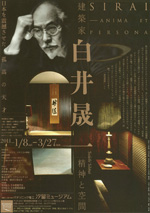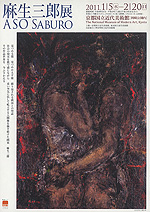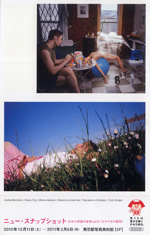 |
Picks is a monthly sampling of Japan's art scene, offering short reviews of exhibitions at museums and galleries in recent weeks, with an emphasis on contemporary art by young artists. |
 |
 |
|
|
 |
 |
 |
 |
| Sirai -- Anima et Persona |
| 8 January - 27 March 2011 |
Shiodome Museum / Rouault Gallery
(Tokyo) |
 |
| This retrospective on renowned architect Seiichi Shirai (1905-83) covers his entire career, from houses to banks to public buildings and art museums. Most astounding of all, however, is his hand-drawn plan for the never-completed Genbakudo nuclear memorial. Conventional models do not do justice to Shirai's genius. If anything, his approach was the diametric opposite of today's reliance on models and computer-generated drawings. Shirai's work demonstrates the primacy of materials and ornamentation -- the nuances of space -- over layout. (For an in-depth review see this issue's Focus.) |
|
 |
|

|
 |
 |
 |
|
Saburo Aso |
| 5 January - 20 February 2011 |
The National Museum of Modern Art, Kyoto
(Kyoto) |
 |
| Saburo Aso (1913-2000) co-founded the New Painters' Group with colleagues Shunsuke Matsumoto and Chozaburo Inoue in the midst of World War II, and he continued to paint with courage and a gimlet eye on the human condition well into the postwar era. Ten years after his death, this retrospective consciously departs from the usual tendency to stress his wartime activities and his somber, murky style. Instead, it seeks to link Aso's work to present-day concerns, offering some 130 examples ranging from oils to sketches to sculptures, and covering his entire career from the 1930s on. |
|
|
 |
 |
|
The New Snapshot |
|
11 December 2010 - 6 February 2011
|
|
Tokyo Metropolitan Museum of Photography
(Tokyo) |
 |
| Subtitled Contemporary Japanese Photography, vol.9: Radiant Moments, this show introduced six snapshot artists: Hirohiko Ikeda, Yuji Obata, Satomi Shirai, Haruko Nakamura, Chikako Yamashiro, and Shigeo Yuki. This seemed to be an ideal venue for Nakamura's work in particular -- but in fact, the images by Yamashiro, Shirai, and Ikeda may more aptly deserve the appellation "new snapshot." Produced in Okinawa, New York, and Israel's Negev Desert respectively, these works prominently feature elements of performance art and theater. (For an in-depth review see this issue's Focus.) |
|
|
|
|
|
|
|

|
 |
 |
|
|
 |
|